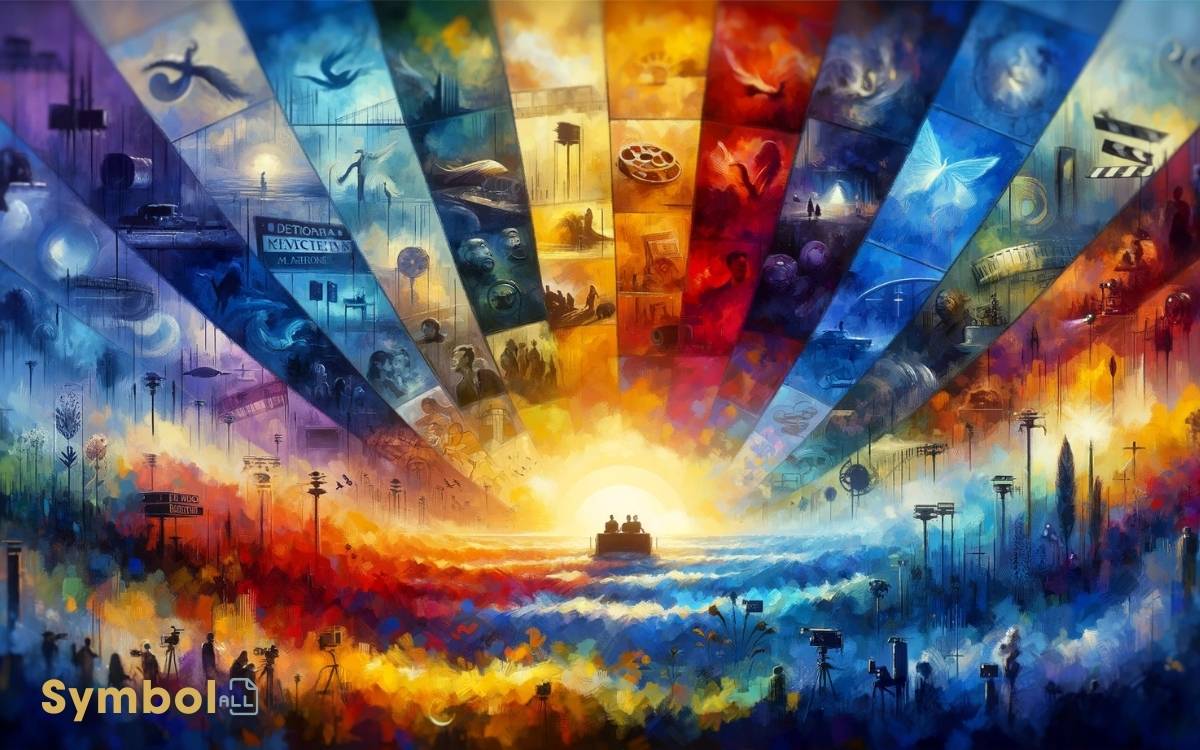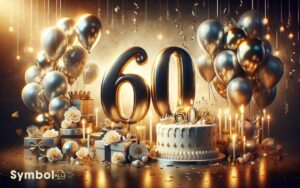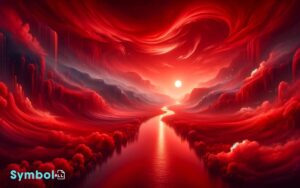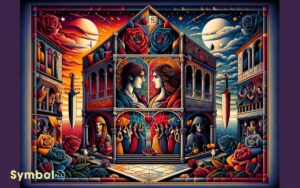Color Symbolism in Movies Examples: Explored!
In movies, colors aren’t just for show; they’re symbols, whispering deeper stories to you. Take the red coat in ‘Schindler’s List’—it’s not just a garment. It’s innocence lost amidst horror, a stark contrast in a grayscale world.
- Then there’s the ‘Matrix,’ where green isn’t just a color, but the essence of an artificial reality, distinguishing two worlds.
- And in ‘Amélie,’ blue captures isolation, translating feelings without words.
- Each hue in films like ‘Black Panther‘ and ‘Sin City’ serves a purpose, from signifying power to cautioning danger.
Grasping these colors’ meanings offers a richer tapestry of the cinematic experience.

Key Takeaway
Color Symbolism in Movies: How Hues Convey Emotions and Themes
| Movie Title | Color Used | Symbolic Meaning | Example Scene |
|---|---|---|---|
| The Matrix (1999) | Green | Artificial reality, cyber world | Green tint in scenes inside the Matrix to represent the digital world |
| American Beauty (1999) | Red | Desire, passion, danger | The red rose petals symbolizing Lester’s desire for Angela |
| The Sixth Sense (1999) | Red | Something in the past is going to be significant | Red doorknob and other red elements appear when the supernatural is near |
| The Grand Budapest Hotel (2014) | Purple | Wealth, royalty | Lavishly purple outfits and decor represent the opulence of the hotel |
| Blue Is the Warmest Color (2013) | Blue | Intimacy, depth of feeling, melancholy | Blue clothing and lighting to reflect the emotional depth of the protagonist’s experiences |
| Schindler’s List (1993) | Red | Innocence, hope, life amid despair | The girl in the red coat as a symbol of innocence amidst the horror of the Holocaust |
| Traffic (2000) | Blue/Yellow | Contrast between different worlds (rich/poor, police/criminal) | Cold blue tones for law enforcement scenes, warm yellows for drug cartel scenes |
| Amelie (2001) | Green/Red | Life, love, vibrancy | The frequent use of red and green to portray Amelie’s imaginative and passionate nature |
| Sin City (2005) | Selective Color | Highlighting elements of the graphic novel, contrast | The use of selective color to draw attention to certain characters or objects, such as red blood |
| Vertigo (1958) | Green | Envy, obsession, the supernatural | The green light in the scene where Judy transforms back into Madeleine, indicating Scottie’s obsession |
The Red in “Schindlers List”
In ‘Schindler’s List’, the poignant use of a red coat not only captures your attention amidst the grayscale backdrop but also serves as a powerful symbol of innocence amidst the horrors of the Holocaust.
This deliberate splash of color amidst the sea of black and white isn’t merely a stylistic choice; it’s a deeply symbolic one.
You’re invited to view the world through a lens that highlights the stark contrast between innocence and the surrounding evil.
The red coat, isolated in color, draws your focus, making the young girl not just a character but a beacon of the lost innocence of all victims.
Spielberg’s choice elevates the narrative, reminding you that in the midst of overwhelming darkness, there are poignant tales of individual lives, making the historical tragedy intensely personal and impossible to ignore.
“The Matrix” and Its Green Hue
As you explore the significance of the green hue in ‘The Matrix’, you’ll find it’s not just a stylistic choice; it symbolizes the digital world‘s omnipresence.
This color choice cleverly differentiates the Matrix from the real world, illustrating the cold, artificial nature of the virtual environment.
Green Hue Significance
The green hue permeating ‘The Matrix‘ isn’t merely a stylistic choice; it’s a deliberate symbol that deeply enriches the film’s narrative and themes.
This color choice isn’t just for show; it’s a deeply embedded part of the film’s DNA, offering viewers clues and insights into the film’s deeper meanings.
Green, often associated with life, growth, and renewal, paradoxically underscores the artificiality and stagnation of the world within the Matrix. It’s a color that signals both the seductive allure and the inherent deception of this digital dreamscape.
Digital World Representation
When you explore ‘The Matrix,’ it’s evident that its unique green hue doesn’t just distinguish the digital world from reality; it captures the essence of the virtual domain’s deceptive allure and underlying control.
- The green tint serves as a constant reminder of the Matrix’s artificial nature, subtly influencing your perception of its authenticity.
- It highlights the contrast between the bleak, controlled digital environment and the more vibrant, albeit chaotic, real world.
- This color choice isn’t arbitrary; it’s a deliberate tool to evoke feelings of unease, symbolizing the characters’ struggle against a manipulated reality.
Understanding this use of color deepens your appreciation of the film’s themes, illustrating how visual elements can powerfully convey complex ideas and emotions.
Blue in “Amélie”: A Dreamy Palette
In ‘Amélie‘, the pervasive use of blue hues isn’t just a stylistic choice; it’s a narrative tool that conveys the protagonist’s deep-seated feelings of isolation and yearning for connection.
This color’s emotional resonance is palpable, enveloping the viewer in Amélie’s whimsical yet solitary world.
Through visual storytelling techniques, the film masterfully uses shades of blue to illustrate the contrast between Amélie’s dreamy desires and her reality, underscoring the power of color in cinematic storytelling.
Blues Emotional Resonance
Delving into ‘Amélie,’ you’ll find that blue hues not only enrich the visual canvas but also evoke a profound sense of whimsy and introspection, integral to the film’s emotional resonance.
- Blue’s cool tones suggest a layer of calm and serenity, wrapping the viewer in a cocoon of the protagonist’s inner world.
- The selective use of blue accentuates moments of reflection, guiding you through Amélie’s emotional journey with subtlety and depth.
- By consistently threading blue throughout the narrative, the film crafts a visually cohesive atmosphere that mirrors the protagonist’s quest for connection and self-discovery.
This strategic use of blue not only beautifies the film but also deepens your engagement with its themes, proving how color can be a powerful tool in storytelling.
Symbolizing Isolation and Desire
Blue’s dreamy palette in ‘Amélie’ masterfully symbolizes the protagonist’s isolation and deep-seated desires, drawing you into her introspective world with each hue.
This choice of color isn’t arbitrary; it’s a deliberate attempt to visually communicate Amélie’s internal struggles and yearnings.
Blue, often associated with melancholy and introspection, perfectly encapsulates her solitary existence and her longing for connection and love.
You’ll notice that the most poignant scenes, brimming with emotion and depth, leverage this color to accentuate her feelings of loneliness and her quest for fulfillment.
This use of blue not only enhances the storytelling but also invites you to explore further into Amélie’s psyche, making her journey more relatable and profound.
Visual Storytelling Techniques
Exploring the dreamy palette of blue in ‘Amélie’ reveals a masterclass in visual storytelling, where color choice isn’t just aesthetic but a window into the protagonist’s soul.
The use of blue hues throughout the film isn’t arbitrary; it’s a deliberate choice that deepens our understanding of Amélie and her world.
- Emotional Resonance: Blue evokes a sense of tranquility and melancholy, mirroring Amélie’s introspective and hopeful nature.
- Creating Atmosphere: The blue tones set a whimsical, almost magical backdrop, inviting viewers into a world where anything feels possible.
- Character Insight: The consistent application of blue also serves as a visual cue to Amélie’s isolation and longing for connection, subtly revealing her innermost desires and fears.
This thoughtful integration of color demonstrates how visual elements can tell a story just as powerfully as dialogue or action.
“Black Panther”: Royalty in Black and Gold
In ‘Black Panther,’ the striking use of black and gold not only signifies royalty but also embodies the film’s rich thematic depth and cultural significance.
You’ll notice that black, representing power, mystery, and elegance, dominates the costumes and settings, mirroring the sovereignty and resilience of Wakanda.
Gold, interspersed with black, highlights wealth, grandeur, and the high status of the characters, especially the royal family.
This intentional choice transcends mere aesthetic appeal, weaving a narrative that honors African heritage and celebrates its influence on modern civilization.
Yellows Caution in “Sin City”
Delving into ‘Sin City,’ you’ll find that the strategic use of yellow not only serves as a visual caution but also deeply enriches the film’s narrative complexity and thematic concerns. Yellow, often associated with caution and deceit, weaves through the film in a manner that’s both subtle and striking.
Here’s how:
- Signals danger: Yellow highlights imminent threats, guiding viewers to tread carefully.
- Embodies corruption: Characters associated with yellow often embody betrayal or corruption, adding a layer of intrigue.
- Creates contrast: Against the film’s mainly dark palette, yellow stands out, emphasizing key elements and guiding the viewer’s focus.
This thoughtful application of yellow not only enhances the storytelling but also offers you a deeper understanding of the characters’ motivations and the film’s underlying themes.
“Eternal Sunshine”: The Surreal Blue
Much like yellow signals caution in ‘Sin City,’ blue in ‘Eternal Sunshine of the Spotless Mind’ crafts a surreal atmosphere that reflects the characters’ inner turmoil and the film’s exploration of memory and emotion.
This hue permeates the narrative, subtly guiding you through the complexities of love lost and the pain of forgotten memories.
It’s not just a backdrop; it’s a character in its own right, influencing mood and perception. Blue tints the most poignant scenes, enveloping Joel and Clementine’s world in a dreamlike quality that mirrors the fluidity and fickleness of human memory.
This strategic use of color deepens your understanding of the film’s themes, making you feel the characters’ longing and loss more acutely.
Purples Power in “The Color Purple”
In ‘The Color Purple’, purple isn’t just a hue; it’s a profound symbol that intricately weaves through Celie’s journey of self-discovery and empowerment.
You’ll notice how its visual impact resonates with the audience, evoking deep emotions and reflections on the themes of liberation and identity.
As we explore its symbolic meanings, you’ll understand how purple frames Celie’s transformation and profoundly affects our perception of her story.
Symbolic Meanings of Purple
Why does purple hold such transformative power in ‘The Color Purple,’ symbolizing both the struggle and the triumph of the protagonist’s journey? In this narrative, purple isn’t just a color; it’s a multifaceted symbol that enriches the storytelling, offering insights into the protagonist’s emotional and spiritual growth.
- Royalty and Nobility: Purple traditionally represents royalty, suggesting the protagonist’s inherent worth and eventual empowerment.
- Spirituality and Enlightenment: It signifies a deeper understanding and spiritual awakening, reflecting the protagonist’s journey towards self-realization.
- Suffering and Survival: The dual nature of purple also encompasses suffering, mirroring the protagonist’s struggles and resilience.
Celies Transformation Journey
Exploring Celie’s transformation in ‘The Color Purple’ reveals how purple’s symbolism intertwines with her journey from oppression to self-discovery and empowerment.
As you investigate further, you’ll notice the strategic use of purple not just as a color but as a narrative device that underscores Celie’s growth. It’s a visual metaphor for dignity, pride, and independence, elements that Celie embraces through her story.
| Stage | Symbolism of Purple | Celie’s Journey |
|---|---|---|
| Begin | Oppression | Subdued presence |
| Mid | Evolution | Glimpses of self-worth |
| End | Empowerment | Full self-realization |
| Overall | Freedom | Embraced identity |
This table simplifies the complex interplay between color symbolism and character development, enhancing your understanding of Celie’s transformative journey. By drawing parallels to color meanings in Greek mythology, the table highlights how hues like purple and gold not only represent Celie’s personal growth but also embody broader themes of power and divinity. This connection enriches the narrative, offering a deeper lens through which to analyze her evolution. Ultimately, the symbolic use of color serves as a bridge between cultural archetypes and individual transformation.
Visual Impact on Audience
The strategic deployment of purple throughout ‘The Color Purple’ profoundly shapes your emotional journey, echoing the protagonist’s path from suppression to liberation.
This visual tactic not only highlights pivotal moments but also seamlessly ties the emotional and visual narrative threads together, ensuring you’re not just a spectator but a participant in the story.
- Symbolism: Purple, often associated with royalty, wisdom, and dignity, underscores the protagonist’s growth and resilience.
- Mood Setting: The color sets the tone, subtly shifting from darker to lighter shades to mirror the protagonist’s emotional evolution.
- Visual Cohesion: It acts as a thread, connecting disparate scenes and characters, reinforcing the film’s central themes.
This deliberate choice elevates the film’s storytelling, making the visual experience as impactful and memorable as the narrative itself.
The Grey Zone in “Fight Club”
In ‘Fight Club’, the pervasive use of grey not only mirrors the protagonist’s internal conflicts but also highlights the ambiguity of his reality.
This choice in color palette serves as a visual metaphor for the blurring lines between good and evil, sanity and madness.
| Aspect | Significance |
|---|---|
| Grey skyscrapers | Symbolize the mundane, corporate world. |
| Grey clothing | Reflects the protagonist’s loss of identity. |
| Dim lighting | Creates a sense of uncertainty. |
| Shadows | Emphasize the dual nature of characters. |
| Grey smoke | Represents the destruction of old values. |
Through this color symbolism, ‘Fight Club’ invites you to question not just the protagonist’s perception of reality, but also your own understanding of societal norms and personal identity.
“American Beauty”: The Red of Desire
Vivid splashes of red in ‘American Beauty’ not only catch your eye but also deeply symbolize the burning desires and unattainable aspirations of its characters. This strategic use of color serves multiple purposes:
- Emphasizes the intense longing and passion buried within the mundane suburban life.
- Highlights the central theme of desire, whether it’s for freedom, youth, or beauty.
- Marks moments of emotional significance, drawing your attention to the underlying turmoil.
This choice of color isn’t random; it’s a calculated decision to make you feel the heat of the characters’ desires as if they were your own.
Through red, ‘American Beauty’ masterfully connects you to its narrative, making the characters’ unfulfilled dreams and hidden passions palpably vivid.
“Vertigo” and the Mystery of Green
Shifting our focus to Alfred Hitchcock’s ‘Vertigo,’ we uncover the enigmatic role of green, a hue that threads through the narrative, embodying obsession and the illusion of the unattainable.
The color green isn’t just a backdrop; it’s a silent narrator, guiding your emotions and deepening the mystery.
Hitchcock uses green to signify moments of revelation and transformation, making it a pivotal element in understanding the characters’ psychological states.
| Scene | Emotion Evoked | Symbolic Meaning |
|---|---|---|
| Green light in Judy’s apartment | Unease, mystery | Hidden truths, transformation |
| Madeleine’s green dress | Envy, desire | Obsession, allure |
| The sequoia forest scene | Awe, serenity | Eternal love, the unattainable |
Green in ‘Vertigo’ isn’t just a color; it’s a multifaceted symbol, masterfully woven into the film’s fabric to evoke emotion and provoke thought.
Conclusion
In your cinematic exploration, you’ve witnessed how colors aren’t just mere backdrops but pivotal storytellers, painting emotions and guiding perceptions.
From the deep reds that bleed desire and danger, to the ethereal blues that whisper of dreams and solitude, filmmakers craft a visual symphony.
Even as we’re propelled into a future where VR might replace cinema, the timeless language of color will continue to shape narratives.
So, next time you immerse yourself in a movie, let the colors narrate their tale, for they hold the key to understanding the unspoken.






